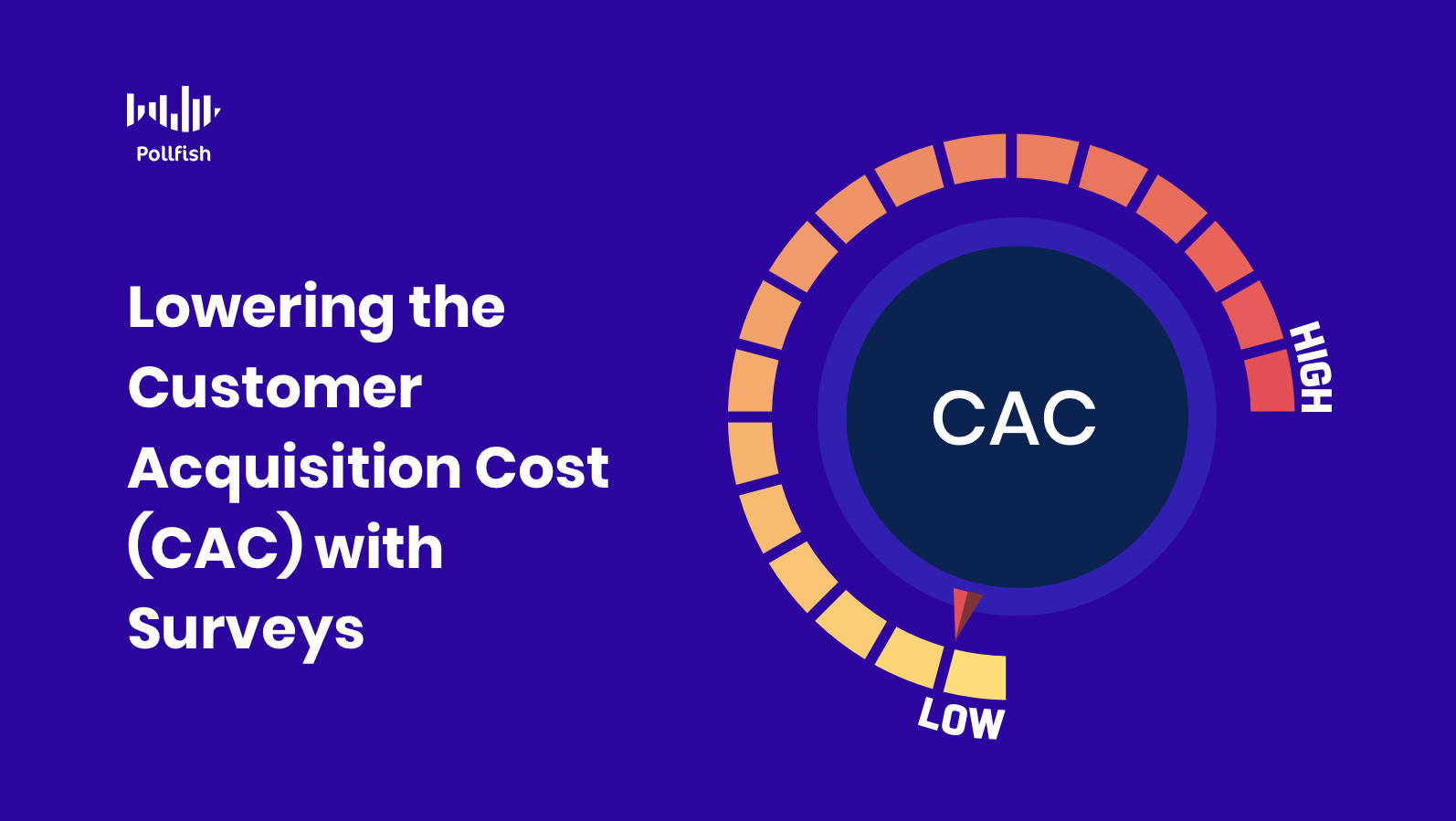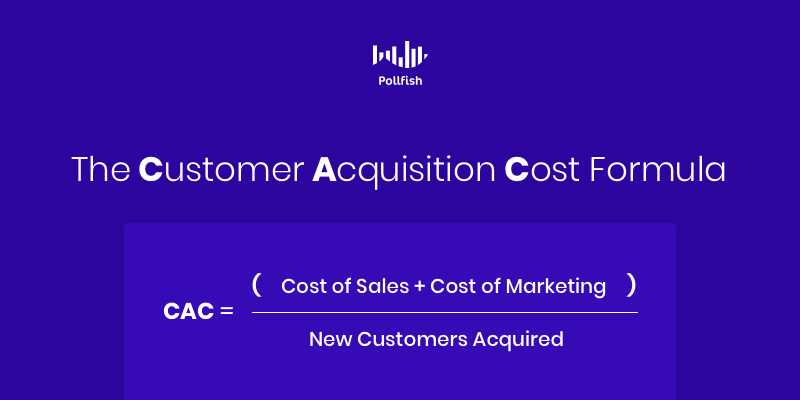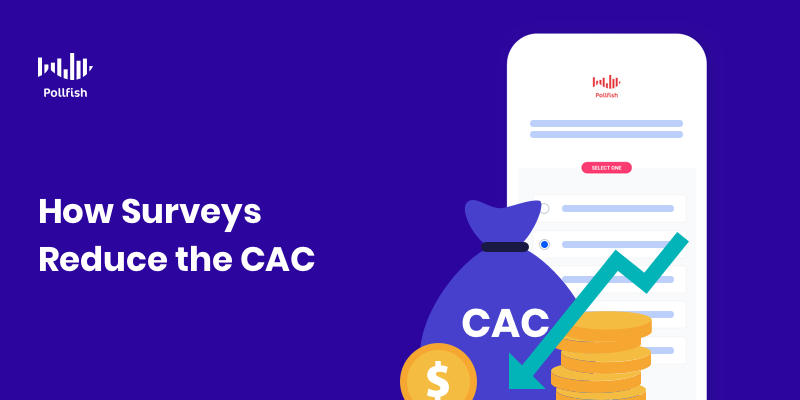Understanding the Customer Acquisition Cost (CAC) and How Surveys Lower It

Acquiring new customers can be costly, making it imperative for businesses to understand their customer acquisition cost or CAC. It is especially important to attempt to reduce this cost, given that acquiring a new customer costs five times more than retaining an existing customer.
Companies also need to contend with balancing their CAC with the worth that a new customer brings to their business.
While customer retention carries a larger value, as existing customers are 50% more likely to buy a new product from a business and 31% more likely to spend more per order, attracting new customers still carries weight in sustaining a business.
That is because in order to retain customers, a business must first gain customers in the first place. Additionally, not all customers will become repeat buyers. Thus, acquiring new customers is generally favorable.
This article explains the customer acquisition cost, how to calculate it, its role in a customer’s overall worth, or customer lifetime value (CLV) and how surveys can help minimize the cost.
Understanding the Customer Acquisition Cost (CAC)
Businesses funnel most of their budgets into their target market, whether it is to understand it via market research techniques, cater to it to boost customer satisfaction or make potential customers aware of it through brand awareness campaigns — all in the name of maintaining a steady flow of customers.
As such, businesses work to acquire new customers and the customer acquisition cost measures the monetary value of acquiring them.
The customer acquisition cost is a metric that dictates the total cost of gaining a new customer, taking into account the expenses incurred from sales and marketing.
Essentially, this metric keeps track of all the money that a company has spent attempting to convince a non-customer into becoming a customer — but only when the targeted individual makes a purchase, thus becoming a customer.
The CAC can also refer to the cost of gaining new leads or a new subscriber.
The objective goal of any business is to keep the CAC at a minimum, as a lower customer acquisition cost entails less labor and resources to convert a potential buyer. Additionally, a low CAC creates a quicker gateway to higher profits and revenue.
The Importance of the Customer Acquisition Cost
The customer acquisition cost is critical to track in a business’s marketing budget — but it carries much more importance than just another logistics matter.
Firstly, the CAC is one of the most expensive investments a company can make, as it incorporates a variety of practices and disciplines to reel in new customers. It relies on the following, all of which requires channeling monies:
- advertising
- SEM
- SEO
- content marketing
- event marketing
- social media
- PR
- branding
In addition to the cost of these activities, companies also invest in human capital, many of which are full-time employees, to carry out these activities. Thus, the most expensive aspect of the CAC is employee salaries. On top of that, some employees are also paid a commission.
The CAC is therefore a major investment and businesses must keep continuous track of it. Only by doing so can they optimize it, therefore lowering it, saving money for the business and obtaining leads quicker.
Businesses should also be wary about their cost of acquisition in order to fuel growth. After all, in order to retain customers, you need to have a steady pool of them.
When businesses neglect to calculate their CAC, they aren’t gauging how effective their marketing and sales campaigns are, whether they are gaining more customers and how valuable those customers are for the long term.
Thus, many key aspects of the business follow suit to this kind of negligence, such as ROIs decreasing. A high CAC can also lead to declining revenue, directly impacting a business’s sustainability for the worse. When the revenue continues to decline with no assessments on the CAC and therefore no plans at curbing it, a business becomes at great risk for going out of business.
When and How to Calculate Customer Acquisition Value
Businesses have the option of examining their customer acquisition value within different timeframes. This involves calculating the CAC once a year to understand it on an annual basis, as well as reviewing it at regular intervals.
It is apt for businesses to measure their CAC on a quarterly basis, given the significance of the quarter and that businesses tend to measure the performance of other business activities, such as brand tracking.
Businesses can also calculate their CAC on a campaign-specific basis, should they seek to understand how a specific campaign affects their CAC.

To calculate your customer acquisition cost: first, you must determine the time period to evaluate such as a month, quarter, year, etc. This will allow you to focus your analysis. Then, gather your marketing, sales and all the other expenses used to acquire new customers.
Plug those variables into the following formula:
CAC = (add all costs of acquiring new customers) / the total number of new customers gained during a time period
For example, a jewelry company that spent a total of $3,500 on marketing collateral and mini-campaigns to draw more customers to its online store and gained 100 new customers would have the following CAC.
CAC = $3,500 / 100
CAC = $35
How to Determine a Customer’s Worth with the CAC
Businesses should never analyze their customer acquisition cost on its own. Instead, they must examine it in relation to another critical metric: customer lifetime value (CLV). This indicates the revenue that a customer will generate throughout their entire relationship with a company.
It’s important to weigh the CAC against the customer lifetime value, given that not all acquired customers bring the same value to a company.
The CLV divulges two key aspects of a customer’s value: their revenue value, along with their anticipated lifespan doing business with a company. Thus, the longer a customer purchases products and services from a business, the greater their CLV becomes.
The CLV allows businesses to discover the most significant customer segments in their target market. This is because even a small portion of these kinds of customers add the greatest value to the revenue.
The CAC depends on a decent CLV. This is because the CLV shows whether a business is sustaining an ROI or losing money. For example, if the CLV of your customers is $300 and it costs roughly $900 to acquire them, that means your business is losing money, with a net loss of $600.
For example, if the CLV of your average customer is only $500 and it costs close to $1,000 to acquire them (advertising, marketing, special offers, labor), then could severely be losing money if you’re not able to pare back your acquisition costs and/or increase CLV through other products and services.
It can be difficult to calculate the CLV for a fledgling business, as it does not have a large amount of historical data. However, it is vital to monitor this metric and compare it with the customer acquisition cost.
Businesses can calculate their CLV on a 1, 3 or 5-year basis. If a company is relatively new, it can compute its CLV via subscription renewal rates (in a subscription model) or repurchase rates.
The most important kind of business acumen that examining the CAC against the CLV brings is whether the customers that businesses acquire yield more revenue than they cost.
Customer Lifetime Value to Customer Acquisition Cost Ratio
When a business compares its CAC with its CLV, it must do so via the customer lifetime value to customer acquisition cost ratio, or CLV: CAC, also expressed as LTV: CAC. This ratio reveals a customer’s value, relative to how much it costs to earn the customer.
It helps businesses adjust various expenditures, such as marketing, sales, advertising, UX and more. Additionally, it illustrates whether a business is slated for sustainable growth and can stay ahead of its competition..
A suitable CLV: CAC is 3:1, as it shows the value of customers is three times as much as its costs to acquire them. When this ratio nears 1:1, it indicates that a business is spending the same amount of money to obtain customers as the customers are spending on a business.
A business with a higher ratio, such as 6:1, signifies that a business is not spending as much as it should on sales, marketing and other means of customer acquisition. This can mean that it is losing opportunities to gain more customers.
For example, if a company has a CLV of $4,000 and a CAC of $1,000, the CLV:CAC = 4,000:1,000 or 4:1.
How Surveys Help Lower the CAC
Surveys can help reduce the customer acquisition cost in a number of ways. This is because surveys can get to the heart of who your customers are, thereby allowing your business to better serve them.
Surveys also allow you to better understand your customers in relation to your overall industry. In this way, businesses can then tweak their offerings, experiences and services to your customer’s liking. They also help you avoid the things that repel them, whether it is a specific topic, messaging or price point.

The following enumerates the other key ways the surveys reduce the cost of customer acquisition.
- They help glean a clear understanding of your customer segments via market segmentation. Without understanding the makeup of your target market, you won’t be able to serve your customers or market to them.
- They allow businesses to implement proven marketing/advertising methods via experimental research.
- They track brand awareness and brand equity, as these aspects contribute to customer acquisition.
- They optimize advertising campaigns, so that customers will gravitate towards a business, thereby lowering costs.
- Surveys help you augment your content marketing strategy to draw in customers across the digital space and increase your site traffic.
- They remove any hesitation or guesswork around any marketing campaign or business campaign at large.
- They foster customer development to ensure a product is needed prior to launching.
- They prevent businesses from spending on wasted efforts or unsatisfactory methods of drawing in new buyers.
- For those with lower budgets, they help businesses settle on one marketing effort over another, rather than spending money on both.
- They gauge the customer satisfaction of existing customers, so that businesses understand how to better reach and serve new customers.
Rounding off Any Acquisition Campaign
As the above section expounds upon, surveys help lower the CAC in several ways, in turn allowing a business to save money on acquisition. However, there is far more to a survey campaign than the surveys themselves.
In order to round off any customer acquisition campaign or market research campaign at large, businesses need the power of a potent online survey platform. Such a platform provides all the necessary software to run a quick and efficient survey campaign.
There are various capabilities that businesses must look for in an online survey tool, such as artificial intelligence and machine learning to ensure relentless quality, an automated checking system that disqualifies low-quality answers, survey fraud and survey bias, along with one that offers mobile-first quality in mobile experiences.
A survey platform that offers all of these functionalities and more will set up a business to lower its CAC and excel at all marketing and research efforts.
Do you want to distribute your survey? Pollfish offers you access to millions of targeted consumers to get survey responses from $0.95 per complete. Launch your survey today.
